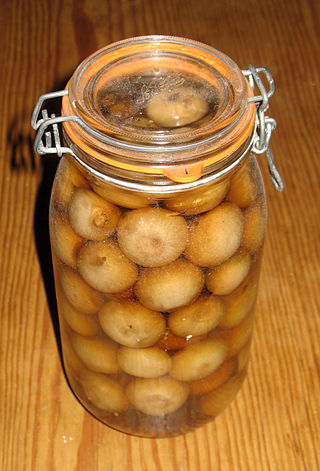
Convolvulaceae, commonly called the bindweeds or morning glories, is a family of about 60 genera and more than 1,650 species. These species are primarily herbaceous vines, but also include trees, shrubs and herbs. The tubers of several species are edible, the best known of which is the sweet potato.

Pickled onions are a food item consisting of onions pickled in a solution of vinegar and salt, often with other preservatives and flavourings. There is a variety of small white pickled onions known as 'silverskin' onions; due to imperfections they are pickled instead of being wasted. They are frequently used as the distinguishing feature of a variation on the Martini cocktail, known as a Gibson.

Euphoria is a genus of scarab beetles in the subfamily Cetoniinae, the flower or fruit chafers. They are native to the Americas, where they are distributed from Canada to Argentina. They are most diverse in Mexico and Central America. As of 2012, there are 59 species in the genus.

The western pygmy blue is one of the smallest butterflies in the world and the smallest in North America. It has reached Hawaii, as well as the Persian Gulf, including eastern Saudi Arabia, Bahrain and the United Arab Emirates.

Hololepta plana is a beetle belonging to the Histeridae family.

Hololepta aequalis is a species of beetle belonging to the Histeridae family. It is found in North American countries such as Canada and the United States where it lives on an elevation of 525–1,370 metres (1,722–4,495 ft) and feeds on dead poplars. Besides poplars, it also feeds on pines, willows, and tulips. Its body is flat and is 8–11.5 millimetres (0.31–0.45 in) long. Its annuli is V-shaped while its palpi is horizontally projecting in front of the head. The species' antennal lobe is under anterior angles of its prothorax while its labrum is free.
Xestipyge is a genus of clown beetles in the family Histeridae. There are at least 10 described species in Xestipyge.
Hololepta vernicis is a species of clown beetle in the family Histeridae. It is found in Central America and North America.

Hololepta is a genus of clown beetles in the family Histeridae. There are at least 100 described species in Hololepta.
Hololepta lucida is a species of clown beetle in the family Histeridae. It is found in North America.
Aradus inornatus is a species of flat bug in the family Aradidae. It is found in North America.
Aradus borealis is a species of flat bug in the family Aradidae. It is found in North America.
Largus pallidus is a species of bordered plant bug in the family Largidae. It is found in North America.

Chimarra is a genus of little black caddisflies in the family Philopotamidae. There are more than 630 described species in Chimarra.
Hololepta vicina is a species of clown beetle in the family Histeridae. It is found in North America.
Hololepta minuta is a species of clown beetle in the family Histeridae. It is found in the Caribbean Sea, Central America, North America, and South America.
Hololepta populnea is a species of clown beetle in the family Histeridae. It is found in Central America and North America.
Malagoniella astyanax is a species of in the beetle family Scarabaeidae. It is found in South America.

Xnipec is a spicy sauce native to the Yucatán peninsula, made with habanero pepper, purple onion, bitter orange juice and salt. Sometimes oregano, vinegar, bay leaf, coriander or pepper are also used. If sweet orange is used, lemon juice can be added to acidify it; if sour orange is used, it is not necessary.








